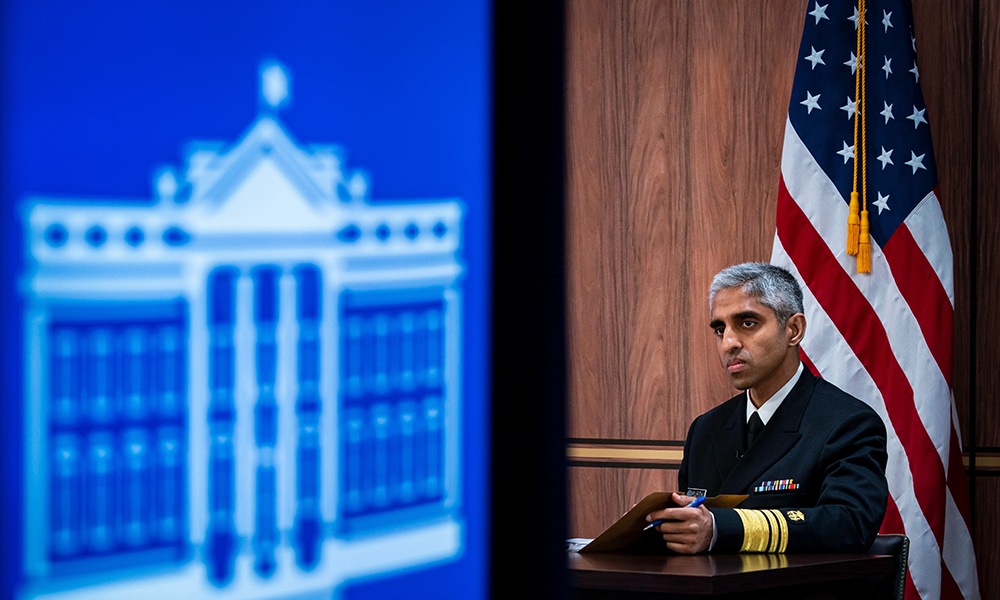
美國衛(wèi)生局局長維韋克·穆爾蒂本周表示,今年秋季,,新冠病毒,、呼吸道合胞病毒和流感等呼吸道疾病感染病例激增,醫(yī)院系統(tǒng)不堪重負(fù),,他敦促美國人對所有病毒采取預(yù)防措施,。
他對美國廣播公司的《早安美國》(Good Morning America)節(jié)目說:“醫(yī)院人滿為患,尤其是兒童醫(yī)院,?!?/p>
今年秋天,兒科醫(yī)院擠滿了患者,,他們感染了幾種不同的病毒——主要是呼吸道合胞病毒,、流感和新冠病毒,但也有類似流感的病毒,,如鼻病毒和腸道病毒,。由于“三重流行病”,,許多醫(yī)院已達(dá)到或接近滿負(fù)荷。有些醫(yī)院甚至超負(fù)荷運(yùn)轉(zhuǎn),,在辦公室,、禮品店、游樂區(qū)和停車場的帳篷里為容納不下的患者騰出了空間,。
但成人醫(yī)院也因為呼吸道疾病感染病例激增而苦苦掙扎,。聯(lián)邦衛(wèi)生官員在11月宣布美國流感正式達(dá)到流行病水平時表示,他們隨時準(zhǔn)備部署軍隊和聯(lián)邦應(yīng)急管理局人員,,并從國家戰(zhàn)略儲備(Strategic National storage)中調(diào)撥呼吸機(jī)等物資,。
穆爾蒂說,美國人可以采取的簡單步驟是勤洗手,、在人流密集的地方戴口罩,、生病時待在家里、接種新冠和流感疫苗,,以便為真正有需要的人騰出醫(yī)院床位,。
“如今,我們采取這些措施比以往任何時候都更重要,,因為這是我們照顧孩子的一種方式,,也可以減輕醫(yī)護(hù)人員的壓力?!?/p>
穆爾蒂說,,聯(lián)邦政府正為有需要的醫(yī)院提供“人員、呼吸機(jī)和設(shè)備”支持,?!拔覀円苍谂c他們密切合作進(jìn)行協(xié)調(diào),以便在特定地區(qū)或州實現(xiàn)床位的有效利用,?!?/p>
在今年秋天經(jīng)歷了一段相對穩(wěn)定的時期后,美國新冠肺炎住院人數(shù)再次上升,。根據(jù)美國疾病控制和預(yù)防中心的數(shù)據(jù),,上周的七天平均住院人數(shù)接近5,000人,此前數(shù)月在3,000人附近徘徊,。
根據(jù)約翰·霍普金斯大學(xué)醫(yī)學(xué)院冠狀病毒資源中心的數(shù)據(jù),,本周美國所有重癥監(jiān)護(hù)室的床位有近80%被占用。絕大多數(shù)床位——近5.6萬張——被沒有感染新冠病毒的患者占用,,只有4000多張床位被感染了新冠病毒的患者占用,。
美國疾病控制和預(yù)防中心的數(shù)據(jù)顯示,上周美國流感住院人數(shù)比前一周幾乎翻了一番。該機(jī)構(gòu)表示,,這一數(shù)字高于2010年以來每年同一周的水平,。本季度記錄的流感病例近900萬例,近8萬人住院,,4500人死亡,。
穆爾蒂說,至少從新冠肺炎疫情角度來看,,與過去兩年相比,,美國今年在應(yīng)對冬季感染病例激增方面處于更有利的地位,因為除了像帕克洛維德(Paxlovid)這樣的抗病毒藥物可以使高風(fēng)險新冠病毒感染患者無需住院之外,,還有先前感染和接種疫苗形成的人群免疫力在發(fā)揮作用,。
他補(bǔ)充說:“但我們需要人們使用這些工具?!彼卮倜绹?,如果距離上次接種新冠疫苗已有兩個月或更長時間,就應(yīng)該接種新的奧密克戎加強(qiáng)針,。(財富中文網(wǎng))
譯者:中慧言-王芳
美國衛(wèi)生局局長維韋克·穆爾蒂本周表示,,今年秋季,新冠病毒,、呼吸道合胞病毒和流感等呼吸道疾病感染病例激增,,醫(yī)院系統(tǒng)不堪重負(fù),他敦促美國人對所有病毒采取預(yù)防措施,。
他對美國廣播公司的《早安美國》(Good Morning America)節(jié)目說:“醫(yī)院人滿為患,,尤其是兒童醫(yī)院?!?/p>
今年秋天,兒科醫(yī)院擠滿了患者,,他們感染了幾種不同的病毒——主要是呼吸道合胞病毒,、流感和新冠病毒,但也有類似流感的病毒,,如鼻病毒和腸道病毒,。由于“三重流行病”,許多醫(yī)院已達(dá)到或接近滿負(fù)荷,。有些醫(yī)院甚至超負(fù)荷運(yùn)轉(zhuǎn),,在辦公室、禮品店,、游樂區(qū)和停車場的帳篷里為容納不下的患者騰出了空間,。
但成人醫(yī)院也因為呼吸道疾病感染病例激增而苦苦掙扎。聯(lián)邦衛(wèi)生官員在11月宣布美國流感正式達(dá)到流行病水平時表示,他們隨時準(zhǔn)備部署軍隊和聯(lián)邦應(yīng)急管理局人員,,并從國家戰(zhàn)略儲備(Strategic National storage)中調(diào)撥呼吸機(jī)等物資,。
穆爾蒂說,美國人可以采取的簡單步驟是勤洗手,、在人流密集的地方戴口罩,、生病時待在家里、接種新冠和流感疫苗,,以便為真正有需要的人騰出醫(yī)院床位,。
“如今,我們采取這些措施比以往任何時候都更重要,,因為這是我們照顧孩子的一種方式,,也可以減輕醫(yī)護(hù)人員的壓力?!?/p>
穆爾蒂說,,聯(lián)邦政府正為有需要的醫(yī)院提供“人員、呼吸機(jī)和設(shè)備”支持,?!拔覀円苍谂c他們密切合作進(jìn)行協(xié)調(diào),以便在特定地區(qū)或州實現(xiàn)床位的有效利用,?!?/p>
在今年秋天經(jīng)歷了一段相對穩(wěn)定的時期后,美國新冠肺炎住院人數(shù)再次上升,。根據(jù)美國疾病控制和預(yù)防中心的數(shù)據(jù),,上周的七天平均住院人數(shù)接近5,000人,此前數(shù)月在3,000人附近徘徊,。
根據(jù)約翰·霍普金斯大學(xué)醫(yī)學(xué)院冠狀病毒資源中心的數(shù)據(jù),,本周美國所有重癥監(jiān)護(hù)室的床位有近80%被占用。絕大多數(shù)床位——近5.6萬張——被沒有感染新冠病毒的患者占用,,只有4000多張床位被感染了新冠病毒的患者占用,。
美國疾病控制和預(yù)防中心的數(shù)據(jù)顯示,上周美國流感住院人數(shù)比前一周幾乎翻了一番,。該機(jī)構(gòu)表示,,這一數(shù)字高于2010年以來每年同一周的水平。本季度記錄的流感病例近900萬例,,近8萬人住院,,4500人死亡。
穆爾蒂說,,至少從新冠肺炎疫情角度來看,,與過去兩年相比,,美國今年在應(yīng)對冬季感染病例激增方面處于更有利的地位,因為除了像帕克洛維德(Paxlovid)這樣的抗病毒藥物可以使高風(fēng)險新冠病毒感染患者無需住院之外,,還有先前感染和接種疫苗形成的人群免疫力在發(fā)揮作用,。
他補(bǔ)充說:“但我們需要人們使用這些工具?!彼卮倜绹?,如果距離上次接種新冠疫苗已有兩個月或更長時間,就應(yīng)該接種新的奧密克戎加強(qiáng)針,。(財富中文網(wǎng))
譯者:中慧言-王芳
Respiratory illnesses like COVID, RSV, and the flu are pushing U.S. hospitals to the brink this fall, U.S. Surgeon General Vivek Murthy said this week, as he urged Americans to take precautions against all viruses.
“Hospitals are filling up, children’s hospitals in particular,” he told ABC’s Good Morning America.
This fall, pediatric hospitals are brimming with an unusually high number of patients who are sick from several different viruses—predominantly RSV, flu, and COVID, but also influenza-like viruses like rhinovirus and enterovirus. As a result of this “tripledemic,” many hospitals are at or near capacity. Some are far beyond it, having made room for patient overflow in offices, gift shops, play areas, and parking-lot tents.
But adult hospitals are also struggling owing to the surge in respiratory illnesses. Federal health officials stand ready to deploy troops and FEMA personnel, and supplies like ventilators from the Strategic National Stockpile, they said in November, as they announced that the U.S. had officially reached epidemic levels of the flu.
Handwashing, masking in crowded places, staying home when sick, and getting the COVID and flu vaccine are simple steps Americans can take to free up hospital beds for those who truly need them, Murthy said.
“It’s more important than ever … that we take these measures, because they’re one way that we can take care of our kids, [and] also relieve the strain on health care workers.”
The federal government is supporting hospitals in need with “personnel, ventilators, equipment,” Murthy said. “We are also working closely with them to coordinate so that across a given region or a state, beds can be utilized at the most efficient.”
U.S. COVID hospitalizations are again on the rise after a period of relative stability this fall. The seven-day average was nearing 5,000 last week after hovering for months in the low 3,000s, according to data from the U.S. Centers for Disease Control and Prevention.
Nearly 80% of all U.S. ICU beds are occupied this week, according to the Johns Hopkins University of Medicine Coronavirus Resource Center. The vast majority—nearly 56,000—are taken by patients who don’t have COVID, and just over 4,000 beds are taken by patients who do.
U.S. flu hospitalizations last week nearly doubled from the week prior, according to the CDC. They were higher than they had been during the same week every year since 2010, the agency said. Nearly 9 million cases of flu have been recorded this season, with nearly 80,000 hospitalizations and 4,500 deaths.
COVID-wise, at least, the country is in a better position this year to handle a winter surge, compared with the past two years, because of population immunity from prior infection and vaccination, in addition to antivirals like Paxlovid that can keep high-risk COVID patients out of the hospital, Murthy said.
“But we need people to use these tools,” he added, urging Americans to get the new Omicron booster if it’s been two months or longer since their last COVID jab.






